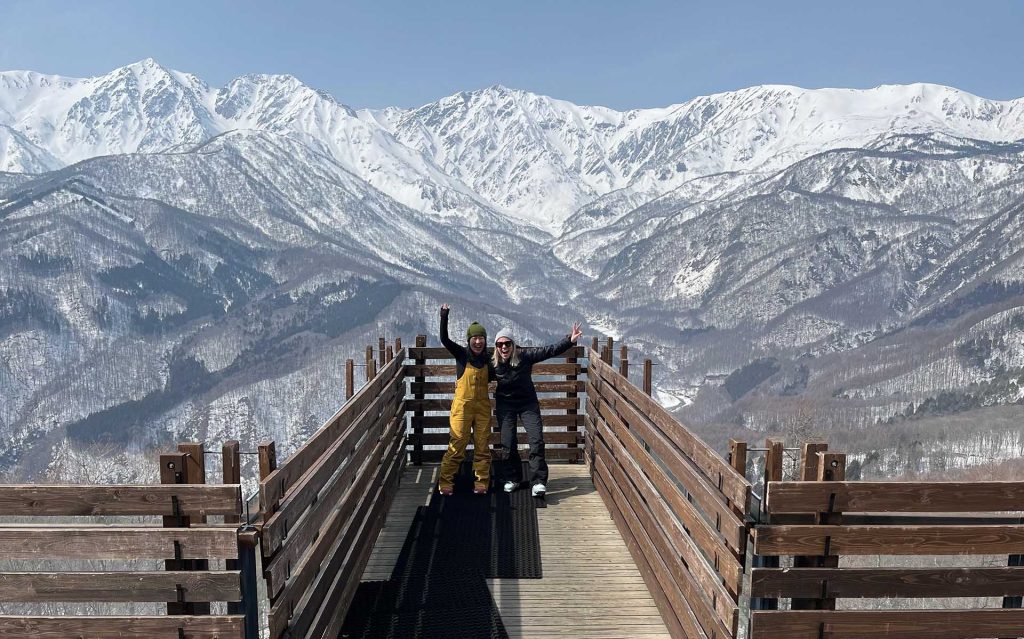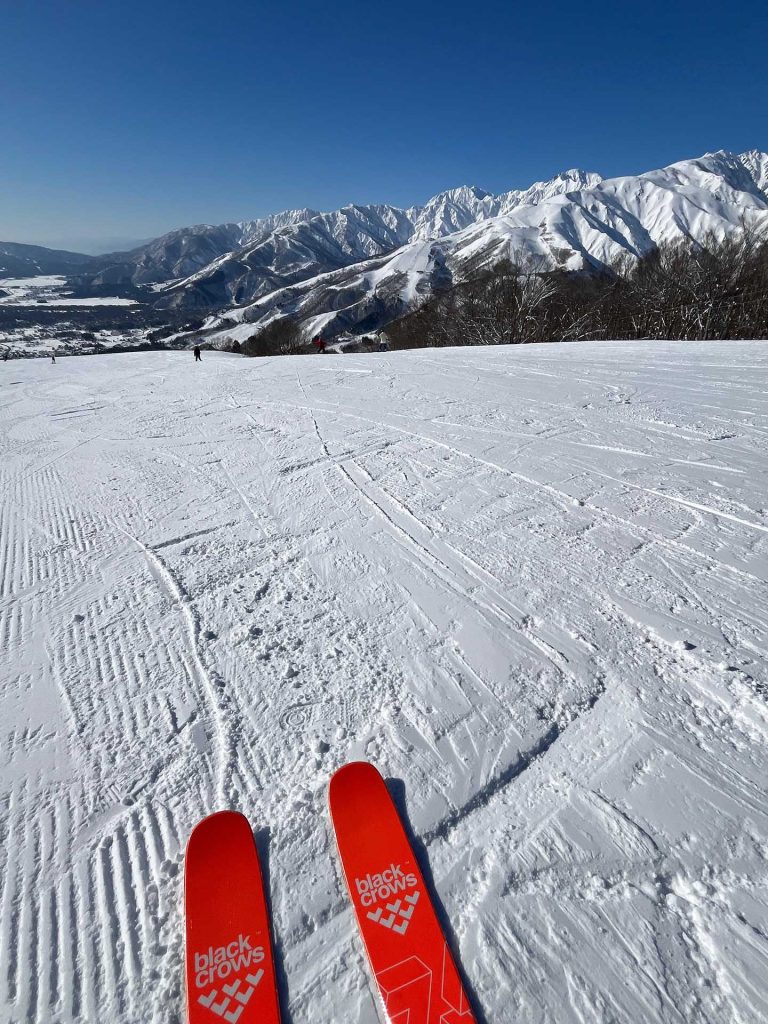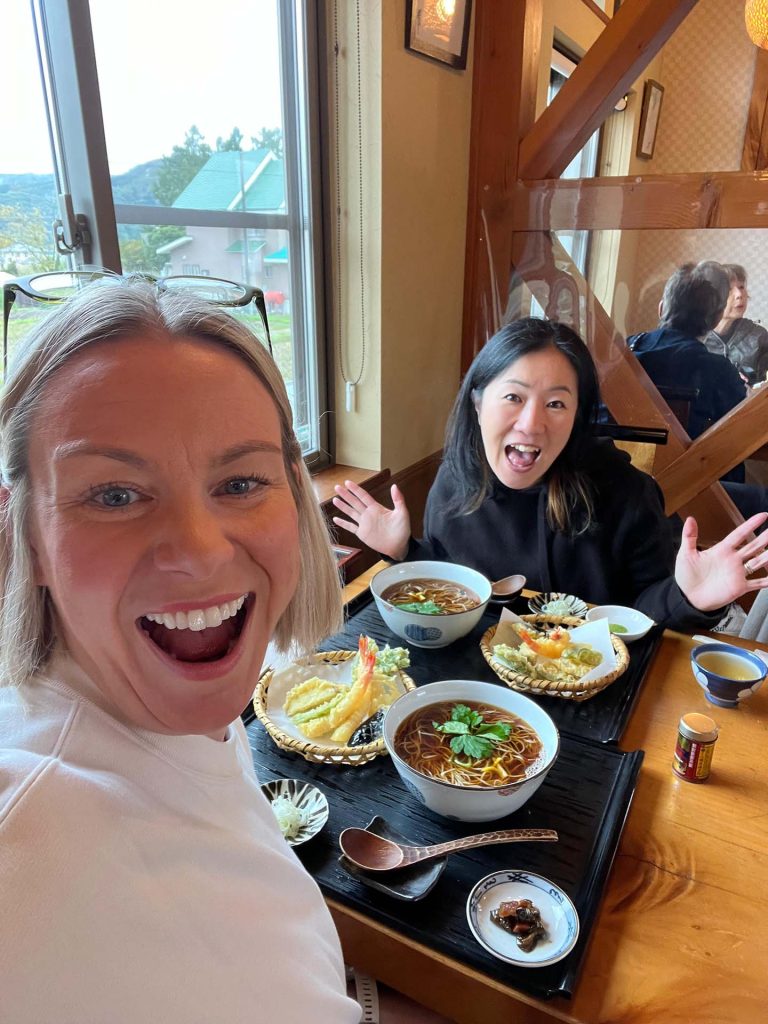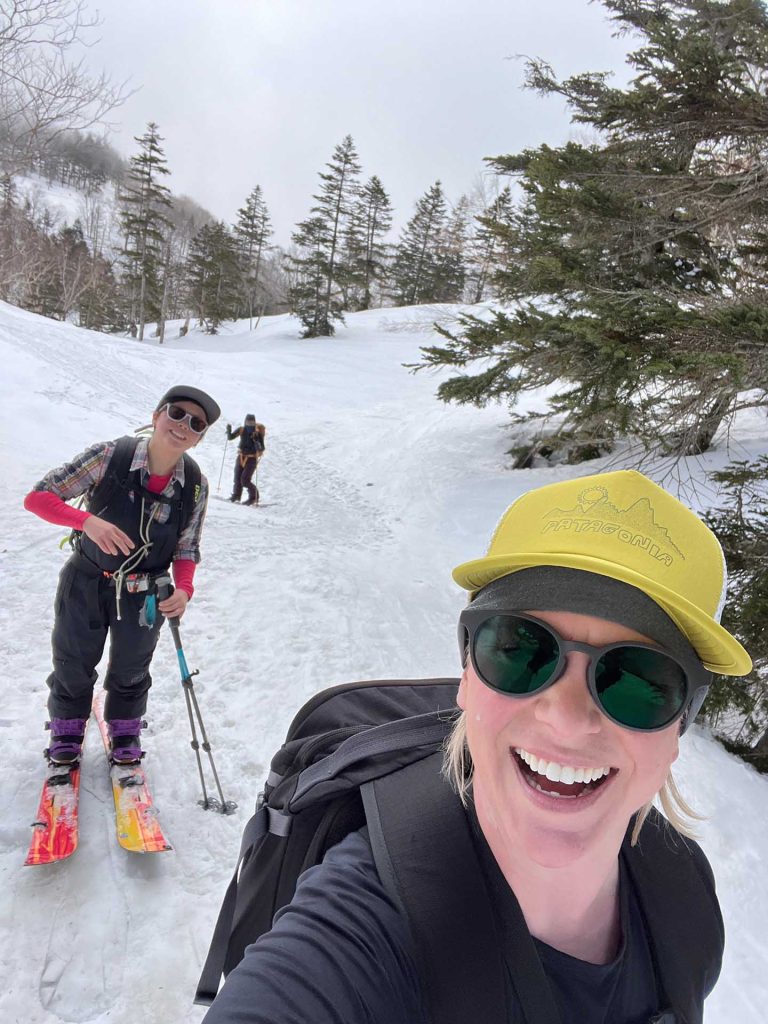Hakuba Tips from one of Hakuba’s Most Experienced Travel Experts: Sarah Mulholland
Sarah Mulholland is one of Hakuba’s most experienced travel experts, having spent more than two decades helping visitors discover the very best of the Hakuba Valley. As Japan Ski Experience’s Hakuba Area Manager, Sarah works alongside a dedicated local team with more than 15 years of specialist experience booking ski holidays in Hakuba.
How long have you been living in Hakuba, and what first brought you here?
It’s been over 21 years now, on and off. I first came after graduating university in 2004 on the JET Programme, teaching English at Hakuba High School. I stayed for the full three years because Hakuba was such an incredible place to live. From about 2004 I decided to stay year-round, and after that I kept coming back for the winter seasons. More recently, I returned to Hakuba again to be here full-time.
Sarah Mulholland, Hakuba Manager, Japan Ski Experience (Left)
How did you get involved with Japan Ski Experience, and how long have you been with JSE?
I started working with JSE in 2012, so over 13 years ago now. I met Ben and Lindsay at the Ski Show in London, and had met them a few times over the years. I was initially invited by JNTO to be at the Snow Show in London, and then met Ben and Lindsay, who invited me to join JSE to help expand the business. Today, Sarah leads Japan Ski Experience’s on-the-ground Hakuba operations, offering a depth of local knowledge unmatched by other travel providers.
How would you best describe Hakuba?
It’s a huge, beautiful valley with 10 ski resorts and a huge amount of varied terrain. All of the resorts are really different from each other. It’s well set up for international visitors, with lots of English-speaking services like ski instruction, great restaurants, rental services, and transport. It’s also well connected to major cultural sites in Japan. The show-stopping part of Hakuba is the incredible Japanese Alps. The Nagano region is full of opportunities to enjoy Japanese culture, and Hakuba has lots of great onsens to relax in as well.
What makes Hakuba unique compared with other Japanese ski resorts such as Niseko or Furano?
Hakuba has a huge variety of resorts — you’ve got 10 resorts on one ski pass, with endless terrain and snow to enjoy. What makes it unique is the spectacular backdrop of the Japanese Alps. There’s also the cultural side of Hakuba, where it’s easy to take day trips to historic and cultural sites. The legacy of the Olympic ski-jumping stadium adds to the experience, and there are lots of smaller attractions around the area that make it special.
How would you describe the snow conditions and terrain in Hakuba?
During the peak winter months, there’s a good chance you’ll be skiing excellent powder snow. The weather patterns here are a bit different — in places like Niseko, it snows lightly almost all the time, but in Hakuba we get huge snowstorms that can bring over a metre overnight, followed by clear bluebird days. So you often get to ski bluebird powder days. In Hakuba we tend to get big snow cycles, followed by sunshine.
How would you describe the skiing and terrain?
There’s definitely a lot of off-piste terrain that has really opened up in recent years. Resorts have taken great initiative to open more tree-skiing terrain, which many people are looking for. The errain in Hokkaido is generally a bit mellower, whereas Hakuba is steeper overall. If you’re going properly off-piste, you’ll need more knowledge and awareness. There’s some amazing steeper terrain, but at quite a few resorts you’ll need to register for backcountry access before heading out.
Because I live here full-time and work closely with Japan Ski Experience’s dedicated Hakuba team, we help guests make the most of the conditions with insider resort advice each day. Norikura has recently added a new lift that accesses some serious backcountry runs. On a powder day, doing laps from first lift is the best — if it’s snowed overnight, 98% of the time you’ll find more snow up the northern end of the valley, which can make a big difference. If it’s snowing, I’d recommend skiing Tsugaike or Norikura.
If it’s a big powder day, make the most of it and ski powder all day. If it’s bluebird, ski powder in the morning and groomers in the afternoon. There are plenty of great restaurants around the resorts — Pilar at Happo-One is quite fancy and a great spot for lunch, so you can stay on the mountain all day. An onsen is a must at the end of the day to recharge for the next one!
Are there any particular ski areas you personally recommend, and why?
Most people stay at the base of Happo-One, so that’s where they tend to ski, but I’d absolutely recommend taking the shuttle buses and visiting the other resorts. Iwatake is great — they have a new gondola, and it’s a really fun mountain. The runs are relatively short, so you can do lots of laps. The new gondola takes you to the summit, where you can ski all over the mountain with great views of the Alps. It’s not too steep, so it’s great for everyone, and Mountain Harbor is an awesome terrace and bakery cafe with panoramic views.
Tsugaike is another great resort. It’s one of the biggest in Hakuba and offers long, leg-burning runs. It suits everyone, with excellent beginner slopes and long groomed runs, plus big tree-skiing areas for advanced riders. The top of Tsugaike also gives access to some of Hakuba’s most popular backcountry terrain. It’s often a bit less crowded than Happo, too.
Do you have a favourite run or backcountry spot in Hakuba?
You can’t beat the tree skiing at Cortina — it’s unbelievable, though quite popular these days. It’s pretty steep (in a good way), and Cortina tends to get the most snow. The trees are perfectly spaced, and it’s such a pure, magical experience.
Sarah’s Expert Advice for First-Time Visitors to Hakuba. Anything to know before hitting the slopes?
Don’t just ski at one resort! The beauty of Hakuba is that it has 10 resorts, all so different from each other — different atmospheres, terrain, restaurants, and mountain views. That’s the best part of Hakuba. I’ve been here for a long time, but it still blows me away how much variety there is. Go explore!
What are the main areas guests should know about — Happo, Wadano, Echoland, etc.? How do they differ?
Those three are the most popular for Hakuba accommodation because they’re central in the valley and well connected with transport, shuttles, shops, and restaurants. Happo and Wadano are close to the Happo-One lifts. Wadano is a bit more tranquil, with accommodations nestled in a peaceful forest and gentler slopes, which is great for families. Happo Village has a bit more buzz and is closer to the steeper slopes, which advanced skiers prefer.
If you’re staying in Echoland, you’ll need to catch a shuttle bus or drive to the lifts, but it’s very central. Echoland has lots of chalets, whereas Happo and Wadano offer more hotels as well as other accommodation types. The main draw of Echoland is the great selection of restaurants, bars, and cafés, all located in one area.
Are there any accommodation types or styles that are especially popular or well-suited to certain travellers (families, groups, couples)?
We have a lot of couples who want a Japanese experience, so I’d recommend ryokan style accommodation for that type of traveller — they have onsen and provide a more traditional stay. Families usually need more space and cooking facilities, so chalets are great for families or larger groups. There’s a huge variety of chalets with self-catering options.
Where do you like to eat or grab a coffee in Hakuba? Any hidden gems?
Two things I’d recommend: first, soba noodles. There are many soba restaurants throughout the valley — soba is a speciality of the Nagano region and a great traditional dish to try. For coffee, “Sounds Like Cafe” in Echoland is excellent. They have a great breakfast and brunch menu, and an incredible chicken burger for lunch that’s very popular. Another spot that’s surprisingly popular is the Starbucks — it’s located inside a stunning building called Snowpeak Landstation. Designed by renowned Japanese architect, Kengo Kuma, it is really something not to miss. The views are incredible and there’s also a tourist information desk, Japanese restaurant and Snowpeak retail store in the same space. Check out our Hakuba restaurant guide for a full list of recommendations.
What après-ski options or cultural experiences would you recommend to visitors who want to see more than the slopes?
Definitely go for an onsen — that’s a must in Hakuba. Some hotels have their own, but there are also lots of nice public ones. There are great day trips from Hakuba too: the Hakuba Snow Monkey tour is excellent and includes a traditional lunch; Zenkoji Temple in Nagano is another great option; and Matsumoto Castle is one of Japan’s few original castles. Matsumoto town itself is lovely to explore, and it’s easy to reach by train if you want to go independently.
Are there particular events or festivals that visitors should try to catch during winter?
There are quite a few fireworks events throughout winter, as well as some fire festivals. Happo also hosts a fire festival. The dates change each year, but you’ll easily find out what’s on when you arrive.
What’s the best way to get around Hakuba once you’re here?
It depends on your group. If you want to explore all the different resorts and restaurants, rent a car — just make sure it has 4WD and snow tyres! If you’re staying in Wadano or Happo, you can easily use the comprehensive shuttle system. Taxis are available but can get busy, so it’s best to book in advance. You can now even use the Uber app to book taxis. If you’re staying at a hotel with a concierge, it’s easiest to have them book taxis for you.
What’s your favourite thing about living in Hakuba year-round?
I love the nature, the people, and the mountains. I love how distinct all the seasons are. Of course I love winter and everything that comes with it, but I also love that Hakuba is a year-round working town. Every season is beautiful but winter and the Japan ski season is just incredible. Definitely come visit Hakuba!
Thinking about visiting Hakuba? Japan Ski Experience is one of the most established Hakuba specialist for international travellers, and Sarah and her local team are here to share the best advice for your stay. Get a personalised quote from Japan Ski Experience to start planning your trip.







